We’re behind, and their foundations mean we’re going to fall even further behind.
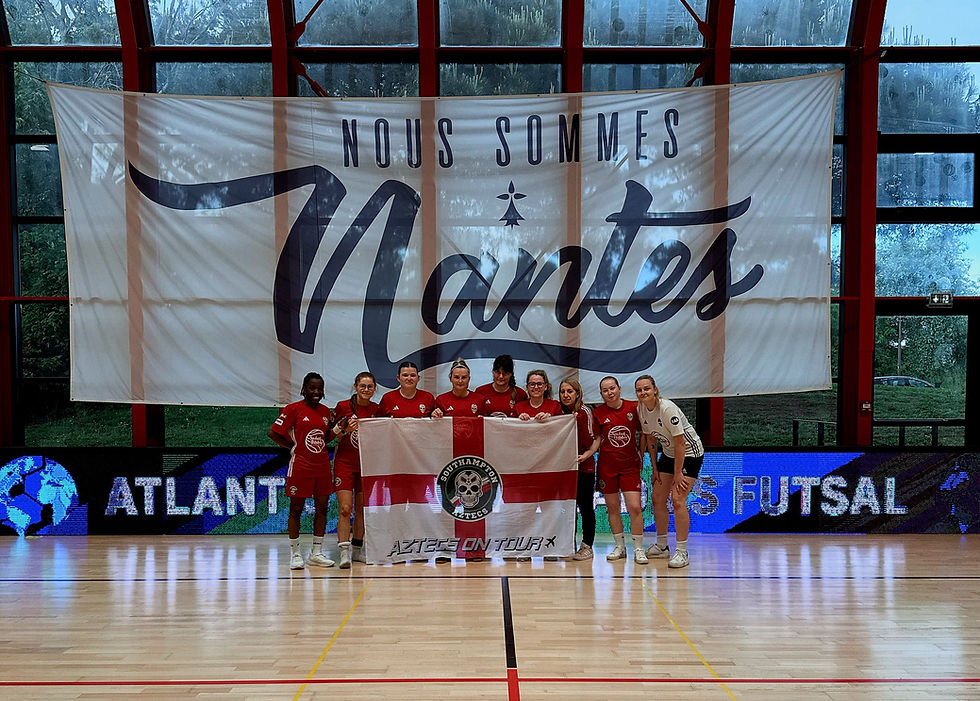
Aztecs On Tour: Southampton Aztecs Women attend the Atlantis Mondial Femenin in Nantes.
With lots of entertainment options available in modern life, why should you spend a few minutes reading this article? Futsal is not a major sport in England, so who cares that the French are better than us? Especially the women! Well, for one thing, it mirrors what can be achieved in football. And if you want England, or your own country, to be better at football, we should really embrace futsal. Both as a sport, and as a football development tool.
France is a contemporary, a rival, a country with a culture distinct from ours, but with centuries of shared history. Our friends across the water are similar to us in enough ways that there can be some lessons learned. Geographically, historically, politically, there are sufficient similarities that we can garner useful information from their successes and failures. Like ourselves, France was a relatively late adopter of futsal, but in a short space of time, they’ve made some significant progress. And now, I’m about to outline why.

Nantes: Walkable, clean, safe, organised, plenty of outdoor space and greenery.
In several of my articles, I have pointed out that those who “don’t do politics” are often in the way of change. Who you vote for matters. What policies you support matters. Many will share the opinion that “kids don’t play outside anymore” which, upon spending just a few moments pondering the causes of this, you’ll realise the reasons are inherently political.
· Many schools have banned ball games at break time.
· Many local parks will close around six in the evening.
· Local councils remove goalposts during the summer months (you know, when kids are actually available, and the weather is good enough to go outside)
· New football centres are expensive, pricing out kids, and are located in places only accessible by car.
· Public transport in England is too expensive, too infrequent, and too unreliable for kids to get around by themselves.
· Ball games are banned in lots of parks, squares, and alleyways, which were previously the make-believe Wembleys of yesteryear.
· Our suburbs are planned around cars, not walking or public transport.
We’ve turned into quite a hostile society towards young people. It’s becoming harder and harder to be young in England. Even local parks now have installed parking machines. You can’t take your dog for a walk, or bring your kids to the play area without having to fork out a couple quid for parking. And we all love those predatory parking companies that enjoy sending threatening letters through your door for going over by five minutes. It’s hard to go anywhere without having to spend money in England, and our harsh, hostile designs are implemented with the purpose of preventing young people from gathering. I get that people are scared of chavs and their graffiti, but we’ve created a generation of bored, hapless kids, and then we blame them for it. No wonder they turn to their Xboxes and iPads.

Facilities in Europe are often built where people actually live, such as this pitch in Barcelona. Easy access means more kids can play.
All of the aforementioned reasons for a decline in outdoor, unstructured, unsupervised play, are political. How public transport is designed and funded is political. What time our parks close is political. Funding for school sport being cut is political. It’s time people started paying attention, and stopped recusing themselves of responsibility. Pay attention, make your voice heard, and be a force for change.
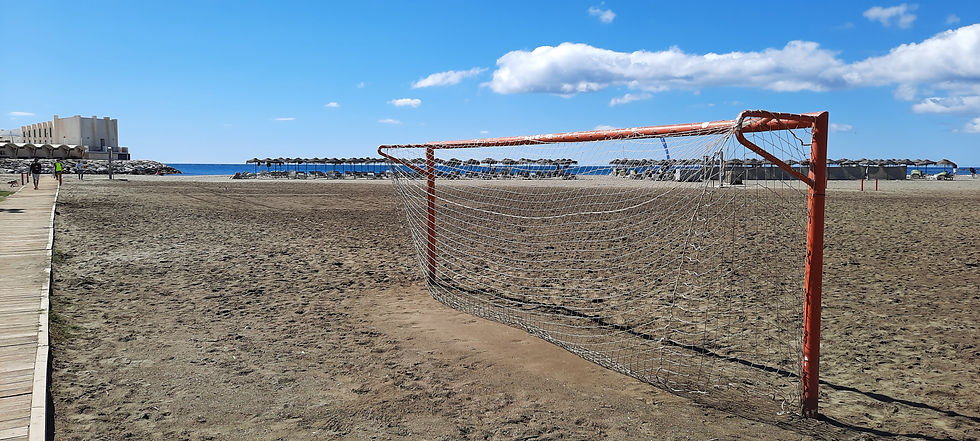
Goals at the beach in Malaga. Free to use, near where people live, lit at night time. Excellent for kids to play with their mates.
Is futsal the magic pill?

Aztecs captain Rebeka Tonks protects the ball from a Nantes opponent.
This is often how futsal is presented. You’ll hear arguments such as “we need to do futsal because we don’t develop enough creative players in this country.” I do think the two are connected, but to me, this sentiment is hitting the dartboard, not the bullseye. Futsal developed in Uruguay and Brazil as a way to make use of indoor space, in growing, overcrowded cities, that were short on outdoor spaces to play football. Even in the 1920s and 1930s, while football was still in its relative infancy, they were playing Olympic tournaments and World Cups. Without futsal, kids played in any space they could. When I think of all the places I’ve played football; the living room, the hallway, the kitchen, the back garden, the front garden, the driveway, the car park, the classroom, the hotel, the swimming pool, the beach, the field, the tennis court, the halfpipe, the alleyway, the motorway during a traffic jam, and many more… To paraphrase Dr. Ian Malcolm from Jurassic Park; football finds a way.
Why did we play in these spaces? Because it was a space, and we had a ball. Sometimes the space was misshapen, sloped, and it could be hard or soft. The ball would change from a football, to a balloon, a volleyball, a beach ball, a sponge ball, a tennis ball, a soft toy ball. It didn’t matter. Kids find a way to turn something into football. With the decline of play in the life of young English kids, futsal is starting (slowly) to fill part of that space. In a way, futsal is codified street football.
Kids in Barcelona just playing in the street. The kind of "jumpers for goalposts" football that England has lost.
The different constraints of all these makeshift football arenas, the changing surfaces, balls, number of players, and other obstacles, forced players to think and adapt. 1v1 in a long hallway encouraged lots of dribbling. Taking shots against a garage door, typically square shaped, really tested your accuracy and decision making, because the goalkeeper would cover much of the goal, but also wouldn’t want to dive on the hard surface. Bouncier balls worked on aerial control, while balls that didn’t bounce meant the ball would be closer to your feet, encouraging dribbling and passing. Plastic and sponge balls were ineffective if hit with the laces, but would move in mysterious ways if toe-punted. When people say “the game is the best teacher” this is what they mean. These different constraints forced adaptation, the unsupervised environment lead to experimentation due to the lack of fear of facing a reprimand from a coach, and the hours of play meant that kids learned through countless instances of trial and error.
I don’t think futsal is the answer, I just think it’s probably our best shot at the moment. If the above opportunities were still available for the kids of today, futsal would not be heralded as this magic pill to fill the gap or change the tide. But in a world of pre-academies, seven-year-olds going on two-week trials, and private trainers charging parents a fortune for toe-taps, ladder drills, and being commanded to “SCAN!” when receiving the ball unopposed in front of a mannequin, futsal has become our best shot
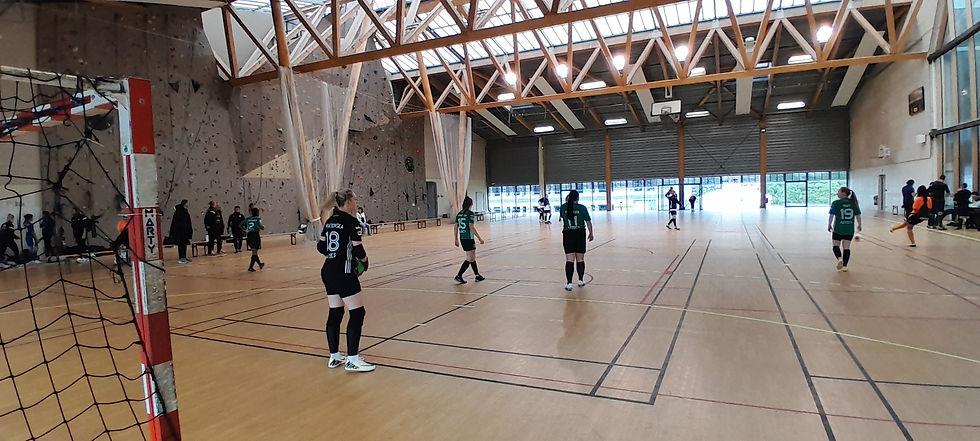
Aztecs warming up before a match at one of the two courts at the Nelson Mandela International School.
That is a lot of weight to place on the shoulders of a developing, under-funded sport, that lacks any significant foundation. For those outside of the English futsal community, let me tell you, it feels like a house of cards, which is only held up and supported by several martyrs around the country. Without this group of dedicated individuals, the sport, in its infancy, is not robust enough to maintain any real development without the miracles frequently pulled off by the aforementioned martyrs.
What are the problems futsal faces in England?
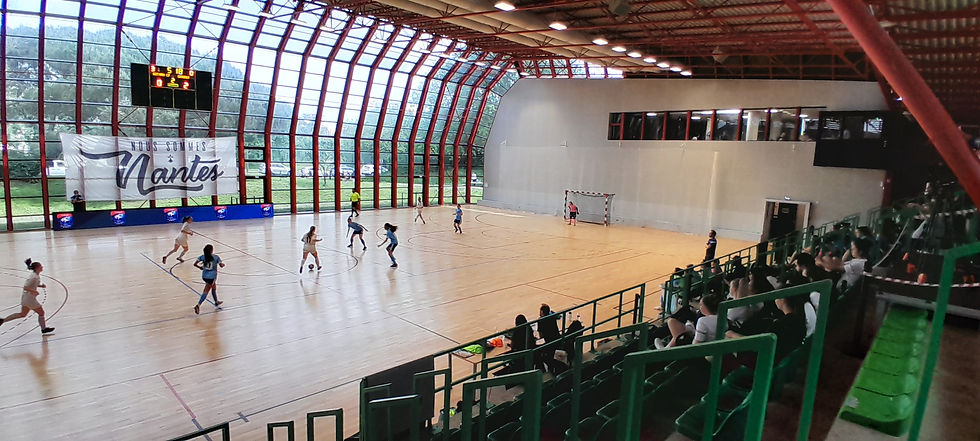
When will we see large crowds at futsal games in England? We're short on courts with such capacity. If we build it, will they come?
So many, that it’s hard to know where to start. Rather than dive into all of them, it would be more convenient to write them in list form. However, I will dedicate a paragraph to something I believe in, which is that futsal has bad PR. For whatever reason, likely the viral clips on social media of tricks, flicks, and freestyle, the average person in England believes futsal is akin to a circus show, where players take multiple touches of the ball with different parts of the body, under the primary intention of embarrassing the opponent. In reality, futsal is about decision making and off-ball movement. It’s much more similar to Barcelona’s tiki-taka than it is to watching a trained seal. Sadly, people don’t notice the terrible defending displayed within those viral clips, never wondering how someone was nutmegged three times and then had the ball flicked over his head. If you defend like a cone, you’ll be bypassed like a cone. Futsal is very one and two touch, all about quick passing and moving, looking to create and exploit moments of superiority.
Let’s have a look at that list;
· Lack of facilities. Not the right size, not the right lines, not the right goals.
· Lack of referees.
· Lack of qualified and knowledgeable coaches.
· Lack of local options for adult players.
· Lack of youth leagues.
· Lack of fans.
· Lack of outlets providing coverage of the game.
· Lack of support from the governing bodies.
· Lack of futsal within schools.
· Lack of professional options.
· Lack of national teams (this is changing, but at continental drift pace).
I could probably go on. That list took thirty seconds. A distinct difference between men’s and women’s is that men’s futsal has a much larger player pool to draw from, because exponentially more men play football than women, making it easier to find someone willing to “give it a go.” Men’s football also has a five-a-side culture that women’s football doesn’t, with many Goals and Power League locations around the country offering five-a-side football every day of the week. It’s easier for men to make the jump across to futsal, because there are more futsal teams, more levels, and there is an quiet acknowledgement of the benefits of having played five-a-side.
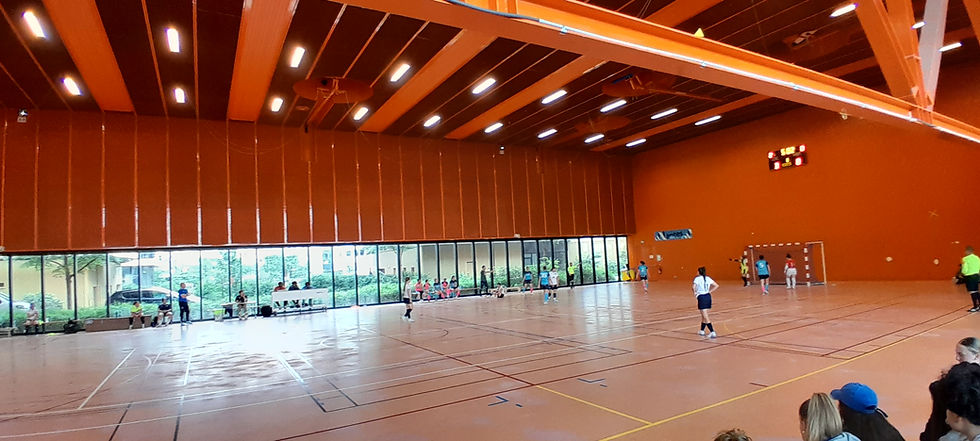
The court at Pre-Guachet in Nantes.
In England, if you’re a woman who wants to play futsal, you either play at a high level, or you don’t play. You might play briefly at university, but I can count on one hand the number of universities who actually provide a beneficial futsal experience for female players. The stark contrast between the men’s (division three) team and the women’s team (division one) at my club is that the men are still complaining about an away game in Bristol (two hours) when for the women, such a relatively short trip feels like a home game. Men can play a variety of serious and recreational levels of football on both a Saturday and a Sunday, with plenty of five-a-side options on weeknights. Women’s football is on a Sunday, and there’s a lack of viable alternatives. Some five-a-side centres do a women's night, typically a Thursday, but historically, these leagues struggle. This means male players can shift and tailor their football and futsal experience in different ways to suit their needs. Women can’t. It’s serious or nothing.
Futsal is such a great sport, and it should be for everyone, of all abilities, and all commitment levels, but particularly if you’re a female, you better be good, and you better not have kids, and you better be willing to travel the length and breadth of the country for games, or else your futsal experience is going to be limited.
What’s it like in France?

The H-Arena for the final between Nantes Metropole and Besiktas Gent.
Granted, my experiences are limited to two tournaments in 2024. We went to a tournament hosted by Sporting Paris in March, and a tournament hosted by Nantes Metropole in May. The Nantes tournament, known as the Atlantis Mundial Femenin, in its tenth edition, is a large, two day tournament, hosting teams from all over France and beyond. This year’s champions were Besiktas Gent, from Belgium, while also featuring ourselves from Southampton, and a team from Quebec in Canada. Last year’s champions were from Ukraine, and featured teams from Spain and Belgium. Twenty-four teams came to Nantes, a city of around 300,000, to battle it out for the big prize. The games featured live broadcasts, and were attended by the French women’s national team coach, who uses the tournament as a way to scout the best French talent for international call-ups.
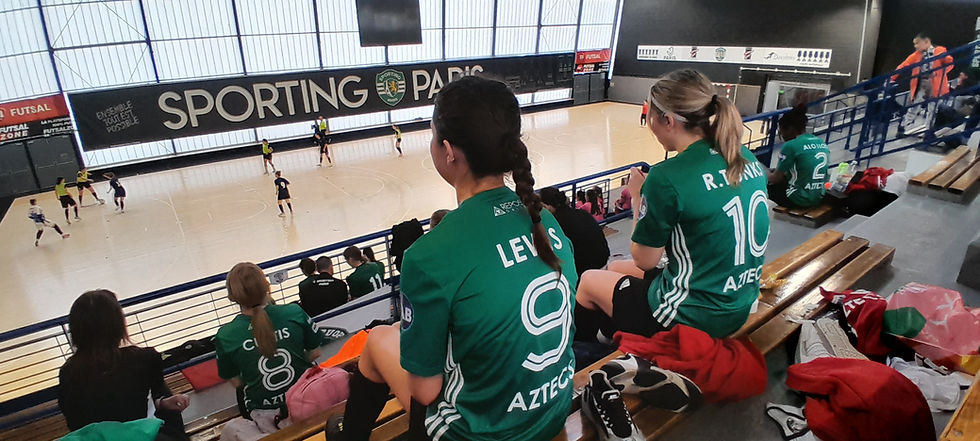
The view from up high at Sporting Paris. We must also build our arenas with spectators in mind.
Being able to peer into the futsal communities of Nantes and Paris provided a window to see how French women’s futsal operates. Many of the players and coaches were talkative, welcoming, and candid in their opinions, allowing us an opportunity to piece things together, and form a much larger, overall view of how futsal in the country operates.
Before even having a conversation with anyone from the French futsal community, the first stark contrast between France and England is the facilities. In Nantes, the main court, at the beautiful H-Arena, was an eleven-minute walk from our hotel. A couple minutes further from the H-Arena was the Nelson Mandela International School, which hosted two international futsal courts inside its sport complex. Across the river via the bridge, just a ten-minute walk, was another international standard court, at the Pre-Gauchet sports hall. And these are the only four we know of, in this small corner of a medium-sized city. Nantes as a city can rival England as a country.
“We have sports halls in England” I hear you say. Yes we do. However, the vast majority of them are too small, don’t have futsal lines, and have the rectangle letterbox goals, not futsal goals. They are also built with netball and basketball in mind, meaning they are typically around 30x16m, whereas the French courts are 40x20m. It’s a completely different game. Fortunately for many European countries, handball is quite popular, and futsal and handball use the same lines and goals. Another factor is that Europeans are quite big into their indoor sports, such as handball, basketball, volleyball, futsal, badminton, floorball etc. This means that when they build a multi-purpose indoor sports arena, it will be used. And when they install seating for spectators, people will come to watch.
I’ve never understood what it is about us in England that makes us resistant to change. Despite being a cold, wet, windy, rainy island, we insist on staying outdoors. Countries similar to ours went indoors a long time ago. Even in Singapore, a tropical country that experiences lots of rain, have put canopies over several of their football pitches. It’s not the 1800s anymore. We have the technology to do the things we enjoy doing, but in a more enjoyable way. But, because we’re English, we’re going to keep on doing the things we’ve always done, the way we’ve always done them.
It's easier to get places!

Outdoor futsal courts like this one by the beach in Salou, near Barcelona, are common all throughout Europe. The backdrop to this is shops, bars, restaurants, cafés, and apartment buildings. It should not be expensive to be outside.
I said earlier that everything is political, and ignoring that will only create problems for yourself. European cities are very easy to get around, relative to English ones. Anyone to have had the misfortune of spending time with me in the car will know my stat about Southampton having the largest number of traffic lights per capita in the country. Trying to get anywhere in the city is painful. The buses are terrible, the trains are expensive and always on strike, and walking on the pavement can regularly feel like playing a game of chicken.
Cheap public transport means more people can afford to get places. Think of how expensive owning and operating a car is. It’s become like having a child. Anytime you go anywhere, you have to make sure that your car will be safe, and they have the accommodations for it. Paying for parking is like paying for a babysitter, and the cost of fuel makes a car another mouth to feed. But even so, the odds are stacked against people in England who don’t have access to a car. What we need is public transport that is so regular, you don’t even have to look at the schedule. You just know that a bus or a train will be there any minute. We only really have that in London, while European cities, even average and smaller sized cities are designed in such a way people who don’t have cars can still live fulfilling lives. We walked around Nantes to all of our games. Cycle paths, bus lanes, footpaths, and car lanes, are all present, but are distinctly separate. You’re not jockeying for space with an inconsiderate or unaware road user, but rather peacefully and blissfully arriving at your destination.
What have we learned so far?
· French facilities are located where people live.
· French facilities are easy to get to.
· There are more facilities in France that are international standard for futsal.
· French people play lots of indoor sports.
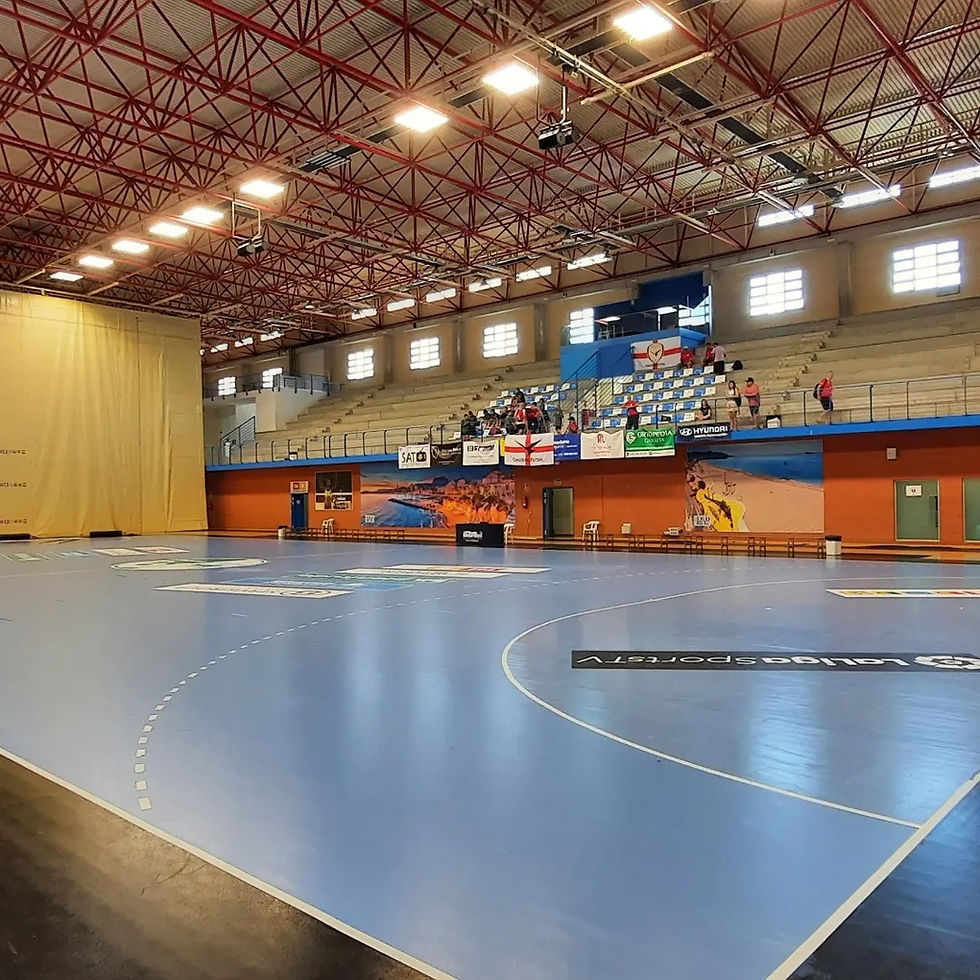
One of many futsal arenas in Benidorm, Spain.
If you want to build a facility in France, you’ll know that the slots will be booked all year round, because these are indoor sports, not just footballers or cricketers avoiding the cold for a few months. You also know that people live nearby and can easily get to your facilities. And the best bit? All throughout Spain and France, their indoor facilities are built, maintained, subsided (sometimes fully or in part) by the local councils and municipalities. This keeps them affordable. Much like their public transport, they see these as necessities, and therefore don’t run them for profit. They want a healthy, happy population, that is able to move around with ease, and will spend their money on fun, useful, beneficial activities. They view a healthy, happy population as an investment, and a necessity if you want to be a developed, prosperous nation.
This is politics. Pay attention.
National or Nothing?
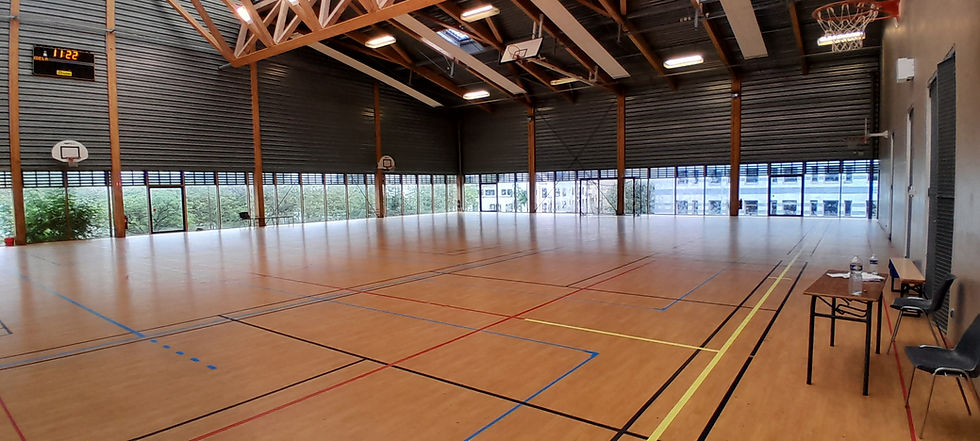
The other court at the Nelson Mandela International School in Nantes.
France is a decent sized country. Bigger than England, but not massive, with a relatively large population. Currently, there is no national women’s league. There is a national cup, but regular league play comes in the form of regional leagues. Paris itself has two divisions to its women’s league. Our national league in England is called the NFS. The last two seasons, there were supposed to be eight teams in the women’s divisions, but due to teams dropping out, we finished with six last year, and seven this year. They cited the travel and the cost as the reasons for pulling out of the league mid-season. However, these regional leagues in France all have several teams that are at, or potentially above NFS standard.
It’s hard to gauge exactly, as these are tournaments with shorter games, sometimes different rules, and teams will likely not attend with all of their players available, or will use different tactics, or implement equal playing time, rather than preferring to keep their better players on court for longer. So having not played them in a proper forty-minute game, under league rules, with full squads available, you can’t pinpoint exactly where they are, but we’ve seen enough futsal to be able to provide more than just a ballpark summary. The best French teams we’ve seen; Sporting Paris, Paris Acasa, Espoir Toulouse, Nantes Metropole, Diamant, would do very well in the English league. Remember that there are several regional leagues in France, and each of them have several teams that are NFS quality. Our national league is like one of several parts of France. Although you wouldn’t say they are massively ahead yet, they are pulling away, and we won’t likely be able to close the gap any time soon.

The view from on the court at Sporting Paris. Imagine if our courts were like this, rather than school halls?
What this does is creates a lower bar for entry. French players can play relatively local, while still having these tournaments, the cup, and the national team. If people within your team in England don’t drive, you’re not getting to games. Away matches often take up your entire Saturday, often requiring players to sacrifice their Friday night too, and risk fatigue or injury for their Sunday football. Your weekend has gone, and taken a significant chunk of your bank balance with it. We’ve had plenty of good players come along to our sessions, who have been interested in playing futsal, but have then decided not to play when they look at the requirements. That’s their choice, and I get it. Instead, we should be looking at ways to make our bar lower, so more women can play futsal. The French talent pool is much wider, and therefore, will grow much deeper than ours over time.
More facilities = more people can play
Facilities that are easy to get to = more leagues, more teams, more levels, and more players
A Greater Base to Build From
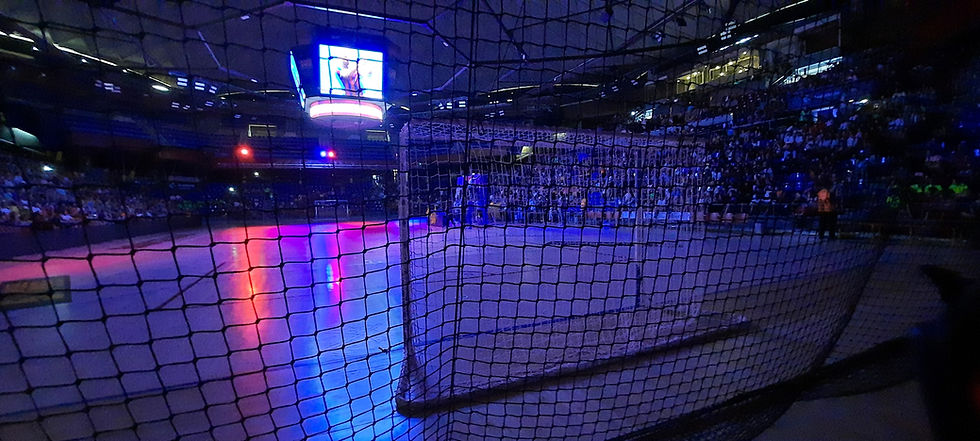
Will we ever get the spectacle of Barcelona futsal in England?
In France, many of these girls will be playing basketball, handball, football growing up. This provides them with a greater skill set and tactical understanding. Although futsal is indoor football, it is probably more similar to the other sports. Fly goalkeeper makes the game 5v5 in one half of the court, and the movements and positioning required to create chances make it almost basketball, but with the feet. Ideas like screening, blocking, cutting are easier concepts to grasp for players with backgrounds in those other sports. In England, we're pulling from footballers that almost exclusively played football, and played a brand of football created for short-term grassroots plastic trophy success.
We'll have young girls come out to our sessions, who are supposed to be footballing prodigies. They've scored tons of goals at youth level, are able to do all the skills, and have shelves full of plastic trophies. You put them on a futsal court, and what you find is that they're really good at running fast in a straight line. That's enough to be very successful on a 110 yard long football pitch, where most players are not above 5'2", the goalkeeper can only reach the crossbar with a step ladder, and several of the participants only started playing organised sport at twelve-years-old. That just won't work on a futsal court. These players either run themselves out of play, or they run themselves into trouble.
If all the eye-rolls I'd received from these prodigies were to be measured like a car wheel turning, I think the distance covered would probably take me to Morocco. Futsal is a game for details, but when players have had years of praise heaped upon them from coaches and parents for winning plastic trophies as a kid, these players are not interested in some guy they've never heard of saying "actually, no, not like that."
"Receive with the sole, because a touch like that might take you too close to the defender."
*Eye-roll
"You can't beat them for speed, because there's too little space. You need to beat them with a change of speed."
*Eye-roll
"Don't shoot from there. It's too difficult to score from distance in futsal."
*Eye-roll
"Don't force passes. The court is so small. It's not like a football pitch where there's still sixty-yards and seven teammates in the way if you lose it."
*Eye-roll
"Sometimes you need to shoot with the toe, because normal types of shots are easy for the keeper to read."
*Eye-roll
"Just because you're in a wide position doesn't mean you should try to cross the ball. We want to avoid needless turnovers, or else the opposition will counter and score."
*Eye-roll

How many futsal clubs in England have a home?
What's that phrase we like? "If at first you don't succeed, try doing what your coach told you the first time." The way we do football in England breeds a form of success that can make players lazy, resistant to coaching, and thinking they know everything already. Their plastic trophies were earned by shooting from outside the box over the head of a 5'0" goalkeeper in an 8'0" goal, and knocking it past defenders that possess the skillset of a cone, with twenty yards of space to accelerate into. That just doesn't work on the futsal court. I feel that, having played basketball and handball, and perhaps some other sports, the French girls would be easier to coach in this regard. They would likely see the game as a series of inter-connected movements from teammates, rather than how many view football, which is to give it to the good player and hope they do something.
Remember though, as stated earlier, futsal isn't a magic pill. We did encounter a couple of teams that were clearly using futsal as a development tool for football. Skilful, technical players, that just did too much with the ball. You can't take extra touches in futsal, because the space behind the defender available to exploit will disappear. Futsal players know how to defend, and they won't dive in when somebody does their river dance routine. These players are often associated with a group that champions "skillz." The Z is important because it implies they are a maverick. Futsal is a team game. 1v1 ability, offensively and defensively, is huge, but the factors within the 1v1 that are most important are your ability to stay on the ball, an your ability as a defender to not get beat. Do your part for the team by not giving the ball away needlessly.

The Aztecs celebrate a goal after Andrea Fast's shot came back off the post, and was tucked away by Hannah Walker.
The point here is that simply doing futsal is not enough to bring significant football development. Football coaches need to do more than chuck a futsal ball on the pitch and encourage players to "express themselves." Players need to be taught how to recognise problems, and deliver solutions. Doing a triple stepover with a roulette and an elastico is no good if the defender is still in front of you. The time it takes to do those skills means there's probably two defenders in front of you now, and the passing lane that was available is now blocked. Futsal develops speed of thought, awareness, combinations, one and two touch play, and how to dominate in both sides of the 1v1. But it won't teach those things automatically. You still have to know what to actually coach.
We have found that the skillz teams full of mavericks who are expressing themselves, are typically the easiest to play against. They dribble themselves into trouble, they don't track back, they have no patterns of play, and they have no coordinated defensive shape. The debate within football coaching that often comes up is; do we want to create one hundred Milners, or one Messi? But I think this is a false-dichotomy, as it implies Messi doesn't know how to be part of a team out of possession, that his only job is to produce magic, and that his game is all about flicks and tricks.
Watching Messi v Gvardiol here, what tricks and flicks is Messi using?
He's actually doing quite boring, simple stuff;
Safe side dribbling.
Protecting the ball with his body.
Feints.
Change of direction.
Change of speed.
Taking too many touches slows you down and gives the defender(s) time to recover. Keep it simple. Move the ball to move the opponent. Move your body to protect the ball. Exploit the space when it appears.
Should we go regional in England?

Closer games and less travel would allow for more fans, but do we have enough good courts to facilitate the growth of spectators? And is the product on the court currently good enough to entice attendees who have no connection to players?
In English women's futsal, we recently had the argument that we should regress to a more regional format. Clubs are struggling with the travel and cost demands of playing nationally, and the belief is that something more regional puts less stress on those stakeholders, allowing for sustainable growth, and creating a lower bar for entry, that may entice more female players. My personal opinion in this regard is that the horse has bolted on that one. We're at a stage now where the gap between the top and the bottom teams in the country is so wide, we can't have them playing each other in the same league. In football terms, it would be like mixing the top three or four divisions of men's football.
Let's create a hypothetical London League. Imagine a football league that included Arsenal, Chelsea, Spurs, West Ham, Brentford, Fulham, Watford, Millwall, Luton, Charlton, Stevenage, QPR, Crystal Palace, Wimbledon, Barnet, Leyton Orient, Sutton United, Borehamwood, Welling United, Bromley, Rushden & Diamonds. The argument is to increase participation and sustainability, with the belief that playing the top clubs would help develop the bottom clubs.
I don't buy that. Firstly, if you're Arsenal or Chelsea, you're only playing around five to ten games that are actually challenging. The rest of the season feels like a waste playing against teams that are significantly weaker, and will likely not put up much of a fight. There's a few teams in the middle, like Watford, Luton, Millwall, QPR who would benefit from more games against teams like Arsenal, Spurs, Chelsea, West Ham, as it would test them and force them to improve. But what would Arsenal get from playing Bromley, Welling, Borehamwood, and Sutton? It would be too easy. They'd likely regress. The score lines would be so one-sided that fans would lose respect and interest in the league.

Divina Alo Ilolo and Hannah Walker hunt a Sporting Besançon player.
And what would those teams learn from playing Arsenal and Chelsea? I think a 3-0 loss has plenty to learn from, but a 15-0 loss suggests that the challenge may have been too difficult to provide any real benefit.
It's too far gone to take backwards steps in England. The game is being propped up by good players and dedicated clubs. We need to maintain that and build the foundations underneath. But I don't know how we do that when we're so far behind on a futsal infrastructure. One way to help would be more links and collaboration with universities and their futsal teams, but this discussion is so convoluted, it needs its own separate article.
Tactical Observations

Will courts like this one in Benidorm ever be common place in England?
The above picture provides some much needed perspective. Not just from an infrastructure point of view, but also from a tactical one. The white lines show a futsal court, and the black lines show a basketball court. Most sports halls in England are basketball sized. That much extra space turns it into a completely different sport. We've found it very difficult ourselves, training in a basketball sized space every week, with our games taking place on international sized courts, to take our training ideas into games. The basketball court is around 75% the width, meaning your two widest players end up being five metres closer. If we take the idea of "move the ball to move the opposition" we're moving them considerably less on a 15m wide court, compared to a 20m wide court.
Futsal is all about timing, awareness, shape, structure, distances, angles, connections. Yet the distances and angles we make in training are different to those we make in a game. It won't seem like much, but it is enough to befuddle players during competitive matches. Smaller courts tend to limit the tactical variance. It's easier to press due to having less ground to cover. Transitions are costly in futsal anyway, but even more so with less distance to goal. How you build attacks and exploit opponents with shape, movement, and rotations changes, and becomes less effective, due to having less space to exploit.
What I found with the French teams is that the intensity of the better teams is very high. They are more used to quick pressing, and lots of short bursts on these large courts. Is it due to basketball and handball? Or is it due to access to proper futsal courts in their training? These players would also really fizz the ball in at each other. It's hard to take a bad touch with a futsal ball anyway, but they were smashing them in to feet. Nobody was out there tickling the ball.
The high press some of these teams used was also a lot more fluid than some of the ones we see in England. The game is a lot more man-to-man, while back home, we're still closer to zonal. Holding shape is an easier concept to grasp, and man-to-man requires a lot of energy and concentration. Like football, futsal experiences tactical trends. FIFA and UEFA provide superb technical reports, detailing how teams are playing at international competitions. Getting man-to-man right, with exchange (passing players on) is very hard to do, but it is even harder to play against a team employing this system effectively. Several of the aforementioned factors have allowed the better French teams to really nail this system.
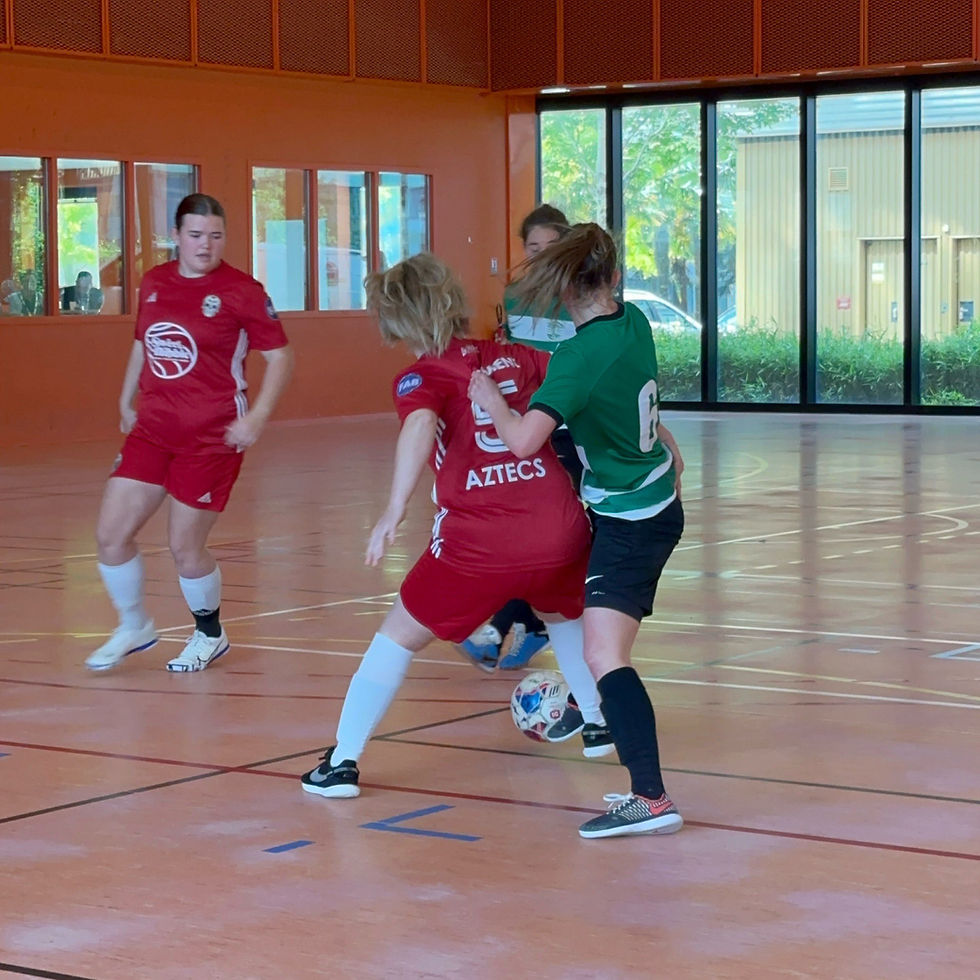
Amy Maidment grapples with a Sporting Paris player for the ball.
The French game is also way more physical than the English game. Overt shirt-pulling, grabbing, tripping, and pushing was largely unpunished by referees, and it was rare to see cards awarded for what are nailed-on yellows back in England. It took us a few games to adjust to the increased amount of contact we were receiving, and also the fouls that just weren't being given, as the threshold for what constitutes a foul was very different. This greatly affects how teams can hunt for the ball, and what players are likely to do in a 1v1. While we ourselves became more physical, and got "stuck in," we also had to attack slightly differently, knowing players would not be protected in the same way if they were using their body to shield the ball.
When it came to pressing, there was very little jockeying. The first defender would be aggressive, going to the ball carrier, and establishing contact, often with the forearm. It wasn't quite a charge in the sense of a one-man band running at the opponents. More that when the first defender went, the second and third went with them, because if they didn't provide cover, passes would exploit the space in behind. Establishing contact allows the defender to ride the player on the ball, forcing them to go where they want them. An aggressive press limits the space and the options of the attacking team quicker than they can find a way to play through it. I'm not sure if this is something teams do in regular league futsal too, as shorter tournament matches are often awarded to the team who scores the first goal.

Andrea Fast closing down a Paris Acasa player.
Rotations are a huge part of futsal, and the better French teams were very fast and very proactive with their rotations. In England, by comparison, it feels like players are thinking on the ball, and deciding in the moment, rather than being a couple moves ahead. The whole point of rotations, combinations, and movements is to unbalance and exploit an opponent. We're looking for instances of superiority;
Quantitative superiority - Numbers: We have better numbers than they do; e.g. 2v1, 4v3 etc.
Qualitative superiority - Quality: We have better players around the ball than they do; e.g. our best dribbler v their worst tackler.
Positional Superiority - Space: We have a space, positions, or support superiority; e.g. it may be 3v3, but they are defending in a flat line with wide gaps between them, allowing for through balls in behind.
What teams are looking at is things like the following;
Can we get our best dribbler on the ball, accelerating into space.
Can we get our best hold-up player to pin their fix, and set the ball to teammates for shots.
Can we use a screen to eliminate an opponent and create a 2v1.
Can we move the opponents too far to one side, creating space on the other side (strong side/weak side).
Can we invite the press, to create space behind the opposition defence.
And many more. But that gives you a basic idea. If we are in a situation that is 4v4 (with the two keepers in their respective goals) we need to use some of our rotations, movements, and combinations to create situations like a 1v1 with space, a 2v1, a 3v2, or even a 1v0. Even ideas we know well from football, like a one-two or an overlap can be enough to unbalance the opposition in a way that creates instances of superiority.
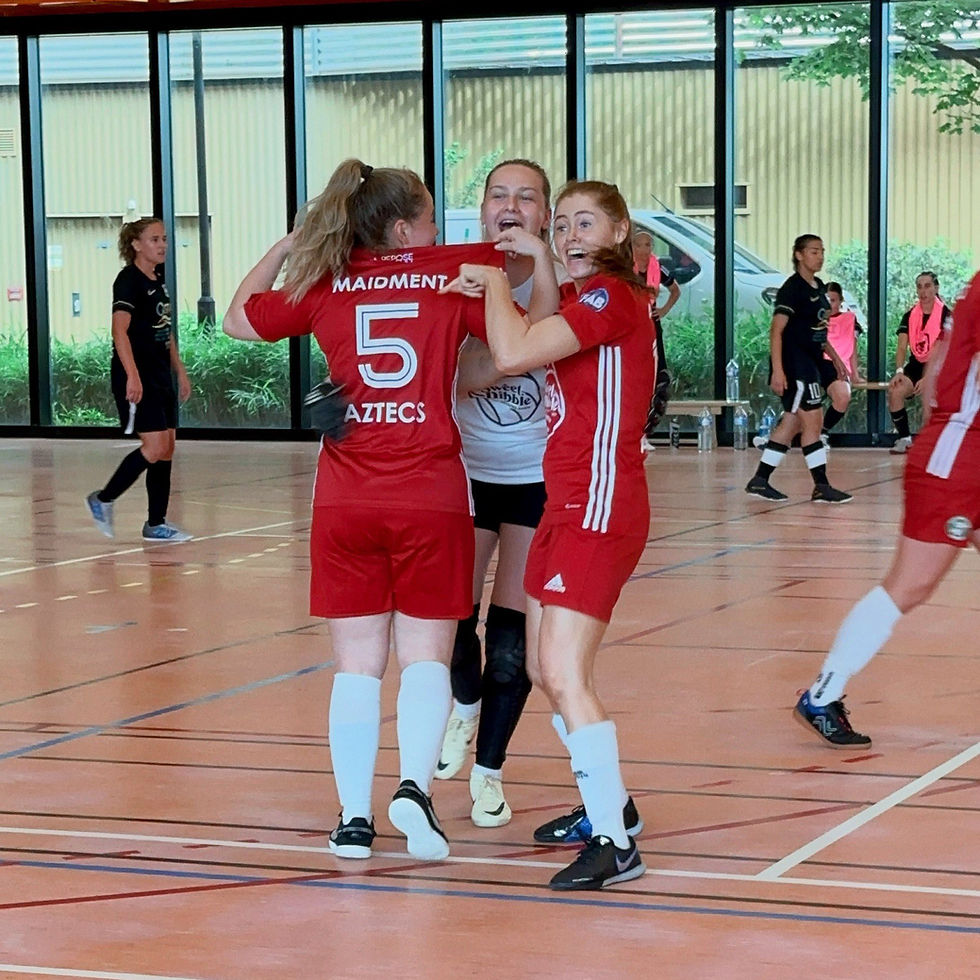
Amy Maidment scores a goal against Kingersheim and wants you to know who got the final touch.
The French teams were so proactive in that regard. In England, too many teams appear to still be in a state where the player on the ball is the one who determines the movement and makes the decisions. It feels like "uh... and then... uh... and then... uh... and then..." which is too slow. We're still in that learning phase of conscious competence, where we know what we're doing, but have to think about it. The better French teams have mostly progressed into unconscious competence, where they're not even having to think about it.
Several of the French teams enjoyed playing with a fly keeper. We have a handful of keepers in England that can do it, however, there are still too many keepers that are goalkeeper only types. The keeper is the most important position, not least because you have to be a shot-stopper and a player in one. Fly keeper creates a qualitative superiority, because bringing out the keeper (or chucking a keeper shirt on an outfield player) makes the game 5v4. Rotations become less of a thing here, because rotations are about creating the free man. In an overload, it becomes about finding the free man. Rotations take time. The ball moves quicker than any human can run, so in a 5v4, get into a good shape and keep moving that ball quickly and effectively.
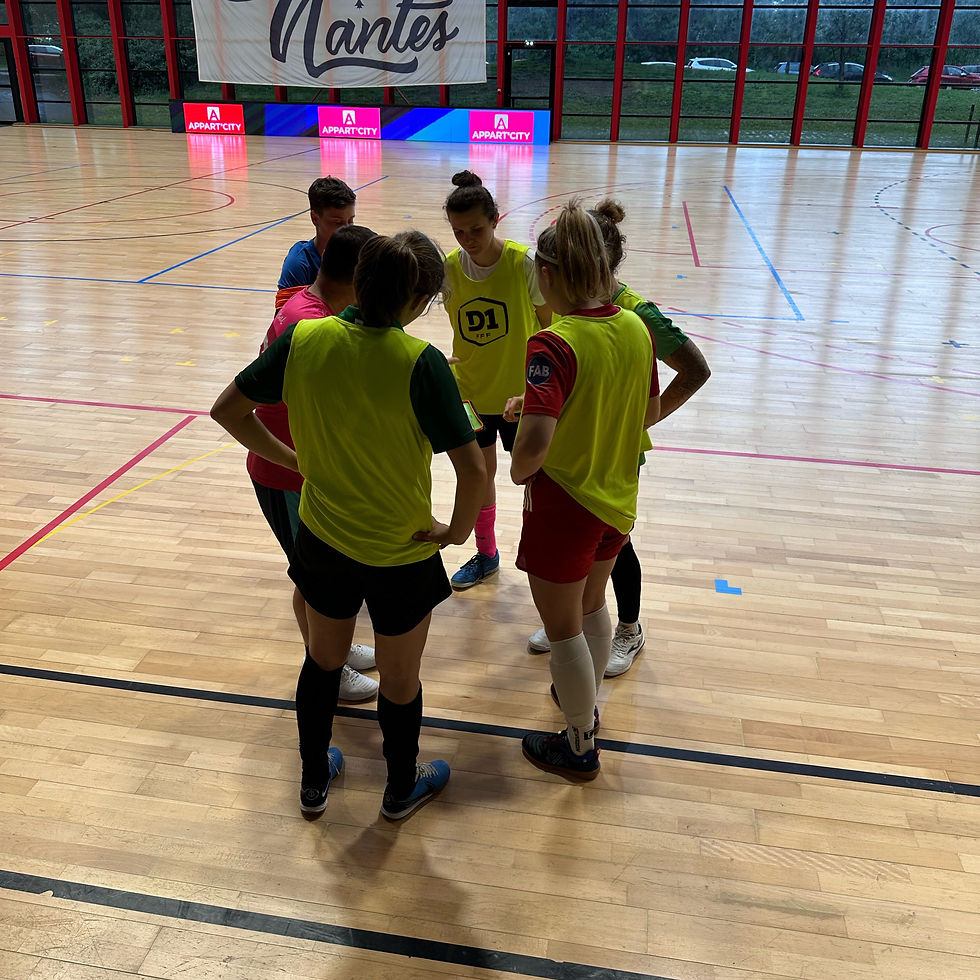
At the end of the first day, the best players from each team were selected for an All-Star match. Aztecs captain, and England squad member Rebekah Tonks was selected, setting up the Yellow Team's solitary goal in a 2-1 loss.
It's not just the rotations that were exhibited that impressed, but also the range of shapes a team might display during one phase of possession. The better teams might do something like start in a 4-0 to invite pressure, then send a pivot forward to become a 3-1, stretching the opponent and creating space between them. This would then become a 2-2, as the opposition would shut off the middle to prevent the pivot receiving centrally. They'd hold the 2-2 briefly, playing the ball around the shape to make the opposition open up once more, than once that pocket appeared, it would become a 2-1-1 with one player darting into the pocket, and the other staying in the corner, in a skewed, asymmetrical shape. All this would be in the space of no more than twenty seconds, and the opposition would not have touched the ball. Top level futsal is supposed to be fluid like this, and we're not quite there yet.
In Summary

Aztecs On Tour: Nantes 2024!
It was a hugely beneficial experience. Lots of games against very different opponents provided us with amply opportunity to learn and experiment. Ironically for us, we've won more games in France this year than we have in England. We've learned so much from doing this, and can't wait to go back for more. If nothing else, it was a hugely enjoyable experience that we won't forget.
It's hard to know how to summarise this article, as I feel there are so many points that need to be understood. And it doesn't just pertain to French women's futsal. At its core, this is a piece on sports development, that has French women's futsal as the wrapping. The obstacles in the way of participation are relevant to many sports in many countries. There are lessons we can learn, but a few tweaks and fixes will have minimal impact without significant overhaul in how we do futsal in England. I don't have the answers for how the game will grow and develop in England, I just have observations from trips to Spain and France.

Dropping pearls of wisdom with my PSV Eindhoven tactics board.
If there's one message I really want people to take home, it's that our infrastructure isn't good enough to be a world conquering futsal nation. We need leagues, referees, players, clubs, fans, but we don't get any of that without the courts. We're not a country that has a large interest in indoor sports, so who is going to build the futsal courts we need? Not us, the clubs. We're all self-funded, run by volunteers, with hardly enough money as it is. Could private companies build them? But then would we run the risk of being priced out further? Do the universities need to enter the national futsal pyramid? Do professional futsal clubs need to get involved, or would that relegate futsal to a funny little sidekick? Futsal isn't yet commercially viable in England, so do we need investment, or will there be no investment until we can prove sustainability and growth?
It's really important that people consider issues like accessibility, location, subsidies, council involvement or funding when we develop sports. If we take our eye off the ball, we end up with brand spanking new astroturf complexes that are too far away for kids to walk to, and are too expensive for clubs to pay the fees. It just becomes a race to the bottom. Sport should be seen as a way to keep us happy and healthy. It provides fulfilment and entertainment. The mental an physical benefits are priceless, yet in England, they're putting a price on it. Remember that everything is political, so make sure you do politics, or else your kids will have nowhere to play.









Comentários